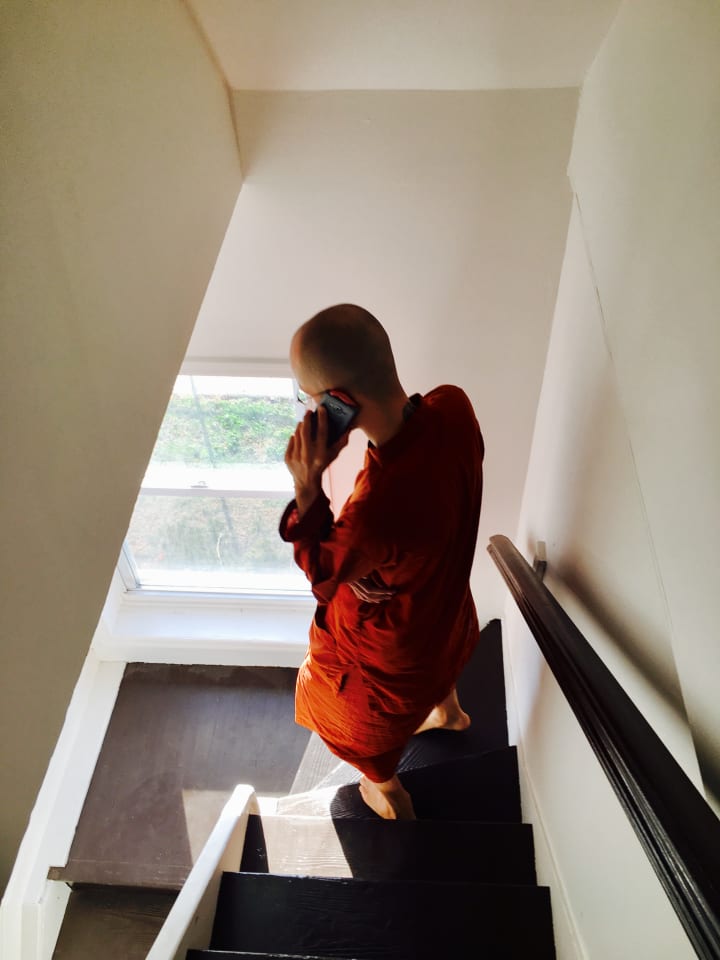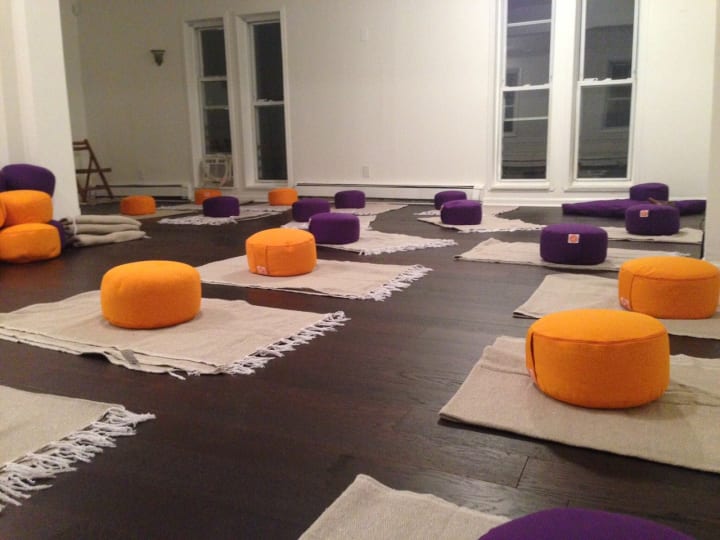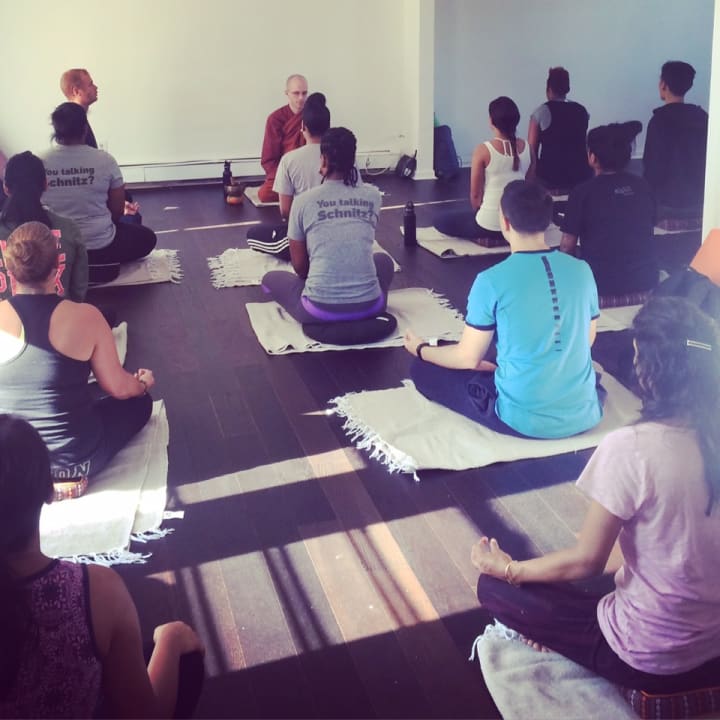A Conversation With Buddhist Insights Co-Founders, Bhante Suddhāso & Giovanna Maselli
Is it OK to hug you or is that weird?

Going out to Rockaway Beach has been on my mind for a while now ever since I heard about Buddhist Insights' new retreat center. I meditate daily and I also happen to help people see their minds by teaching meditation. I met Co-Founders of Buddhist Insights Bhante Suddhāso and Giovanna Maselli, in upstate NY when I attended their first organized weekend retreat last fall. Their mission is to connect monastic teachings with lay-people and now have a home right here in Rockaway Beach, NYC. Usually one has to travel a couple of hours to go on a get-away meditation or yoga retreat, but not anymore. Last week they hosted their first week long meditation retreat Dec. 26 - Jan. 1, 2017. Not to worry if you missed it... they are plugging away at keeping programing flowing.
Complying with ancient Buddhist tradition, Buddhist Insights operates entirely on donations (dāna), through the generosity of its supporters, attendees, and grassroots contributions.
I had the opportunity to catch up with Bhante and Gio just before the retreat started. Come with me on a tour of Buddhist Insights, a monk's home and retreat center right here in Rockaway Beach, NYC. I felt right at home.
Buddhist Insights Retreat Center

photo courtesy of Kim Stetz
Rockaway Summer House
504 Beach 68th Street
Rockaway Beach, NY 11692
Kim Stetz: You found this beautiful house and turned it into a retreat center. How has organizing the rooms and furnishings been?
Bhante Suddhāso: That's the teacher's room, most of the time it will be my room, but if we rent out the whole building to somebody to do their own retreat I might go and stay somewhere else. There's four full baths, one on each floor, with showers. Main dorm room has space for seven people to sleep. We have folding Japanese futons and Tuft & Needle mattresses that come in a box that's about a quarter of the size of the mattress and it's super compressed and vacuum sealed. You slice open the bag and the mattress explodes into form. They're very comfortable and also an ethical company. We got all of our mattresses sponsored - all donated to us. They see it as a marketing thing. People come here and use a Tuft & Needle mattress and say, "This is pretty neat - I want one." The Japanese folding mattresses, in the morning people fold them up and store them in here in our new shelves we just installed a couple of days ago. During the day, this room is completely open if people want to do yoga or hang out or whatever during their break time it's an open space for other things besides a dorm space.
Kim Stetz: I like the compact mattress idea. It's very economical - put your stuff away. I really appreciate the economics of retreat life in my everyday life. With all the rooms and floors, are you doing co-ed floors? It's so light and bright!
Bhante Suddhāso: Each room will be designated either male, female or all gender.
Then the plumber called. This Millennial monk is on the ball!
While he spoke very briefly to the plumber, I had a chance to photograph all the wonderful splashes of color - fabrics and linens donated by two of my favorite made in India luxury linen John Robshaw Textiles (a personal friend and yogi) and Kerry Cassill (been wearing her soft exotic printed dresses for decades).
Millennial Monk

photo courtesy of Kim Stetz
Then there's the esthetic of the place, we painted all the walls white and dark brown flooring everywhere. The overall visual esthetic is very simple. It's very clean, simple, austere. Then there's these little splashes of color that you find here and there. Rather than having the whole house be colorful, vibrant and gaudy, instead the house is very simple and austere, but then there's these little visual splashes which makes it more special, makes it more unique. The overall feeling communicates this feeling of spaciousness and brightness which then helps settle the mind. To keep it from being completely boring, there's these occasional touches of color you find around the house. This neighborhood we chose is fairly quiet. People who come out here, out to Rockaway, the first thing they say is, "I can't believe this is New York City." Rockaway has a completely different flavor than most of NYC. It's very quiet it's very peaceful. It's a relatively small community. The overall vibe is very laid back.
Kim Stetz: When you left the monastery, did you ever imagine you'd have a retreat center and a place for people to come and practice?
Bhante Suddhāso: It was never my plan. It came about very organically actually. Depending on how far back you want me to go, originally when I went I went to live in a monastery, I thought I was just going to do my own practice for however many decades it took for me to attain Enlightenment. And that was it. I would just go off and live in the forest and practice meditation until I attained Enlightenment. Of course that's what I was doing for many years - just practicing and focusing on developing myself. But then a few years ago, I got into teaching and I found that to be incredibly nourishing to share the gift of The Dhamma with other people. To be able to help other people start to experience the same benefits that I've been experiencing from the practice. Also noticing that the practice of teaching and providing the gift of spiritual practice to others was nurturing my own practice - it was helping me develop these very positive qualities of compassion and kindness and generosity within myself. One doesn't necessarily need to be isolated in seclusion in order to make progress. You can make progress even when you're mixing with other people in society if you're careful to keep yourself pointed in the right direction. When I came to NYC, the idea was I was just going to be here for a couple of weeks, stay in a temple, I'd do some teaching and then I'd go back to another forest monastery somewhere. I'd already been doing this once in a while. In my mind, this was what was going to happen the last time, but then I got to talking with Giovanna, talking about how hard it is for people in urban centers to connect with Buddhist monks and nuns because most of them live out in the middle of nowhere. Of course you do get some monks and nuns living in the city, but most of them are more priests than monastics. Their role is more like a priest providing for ceremonial aspects like pujas than providing retreats. It's all well and good, it's just not what most Western Buddhists are interested in. What it means for Western Buddhists who tend to be more interested in meditation practice, have a very hard time finding monks and nuns who teach meditation practice within cities. One of the very few who you can find around here is Bhikkhu Bodhi, but he's not living in the city. He's living two hours north of the city.
Kim Stetz: Your robes are Theravada tradition. Did you start out in this lineage? Is Bhikkhu Bodhi your direct teacher?
Bhante Suddhāso: Yes he is, but I don't have a single capital T teacher, but he's one of the monks whose opinions I take very seriously. I do have two or three monks whose opinions I take very seriously. One is my own preceptor, the monk who ordained me, at the Abbott Abhayagiri Buddhist Monastery, Ajahn Pasanno. I started with Zen Buddhism, Soto school, and still have some connections with that school, in fact I'm bring my main Zen teacher out here in February, Reverend Myō, he runs the Hartford Street Zen Center in San Francisco. Predominately my style and approach is Theravadan based because that's what I found works best for me - what I resonate with most strongly. I still have some ties with the Zen school and I sometimes communicate from that framework because the framework for communicating The Dhamma is quiet useful, particularly for certain kinds of personalities - it's very useful. I do use that perspective from time to time.

photo courtesy of Kim Stetz
Kim Stetz: I think it's exciting to have a space here in NYC for a retreat atmosphere. You're still in your home town, you're not too crazy far away, you can still hear planes and familiar things. I think there are a lot of fears and apprehensions that come with one being quiet for days on end. Another thing while on retreat - questions like where am I going? Am I going to come back? Am I never going to want to come back? Like there's some abduction type of thing that might happen. All kinds of crazy stuff that goes on in the mind. It's great to have this center right here!
Bhante Suddhāso: Part of it is just the hassle. A lot of it is New Yorkers and urban people in general, a lot of people just don't have cars. Yeah, like you had that experience of what a pain it is to get up to these places sometimes. (Laughing)
Kim Stetz: Yeah, I took the the bus up (I didn't print both sets of tickets and almost didn't continue on at the change over about 40 minutes away from the destination because they wanted me to purchase the other half which I had, but didn't print up. The bus driver ended up buying me the ticket - it was my birthday). Then there was some cab company that delivered prescription drugs in the area of the retreat between the hours of 3-5p. I had to call "Drug Mike" and maybe he'd bring me the 3 miles to the retreat farm if he had a delivery. Thankfully, you and Gio found transpo for me!
Bhante and Gio had a lot prep work to do before the retreat. The center was still under construction. I trailed behind Bhante, asking questions, not wanting to hold him back from his work at hand, in particular, stocking kale in an extra fridge. I chatted with Gio for a little bit about business, plans for the back yard and is that a tee-pee back there?

photo courtesy of Buddhist Insights
Giovanna Maselli: Did you see the back yard? It's huge! It's 5,000 sq. ft. We're going to have a garden and grow lots of vegetables for the retreats. We have a tee-pee, it's 250 sq. ft. Originally I used to use it for events at the beach. I used to work with the Rockaway Summer Project, started out as a zine, then a pop-up store - a mixed boutique of artists and indie designers. We used the tee-pee to do workshops, and showcase the artisan's wares.
Kim Stetz: Does a Buddhist monk tweet and all that stuff?
Giovanna Maselli: (Laughing) He's pretty technological I have to say, but I do most of it. He's not that Millennial. He's 30 - he is a Millennial, but he's an old soul. We're making the retreat center accessible to people. I think it's a good thing to create a dialogue with other meditation teachers in the city. I'm fairly new to Buddhism in the sense that I got into Buddhist meditation shortly prior launching Buddhist Insights. We've been inviting monastics from different traditions, but then hopefully with this space, we start more of a dialogue with different organizations that have lay teachers also with different spiritual traditions. I personally want to learn more about Transcendental Meditation. The idea that this place becomes a destination where you can learn about obviously Buddhist monasticism and about different spiritual traditions. Have a dialogue like, "What is yoga?" (laughter) it's like a big thing - aside from getting a nice body from doing it - where does it come from? We're bring this message forward. We're orthodox teachers - the teachings are presented not in such a traditional way, like a Street Retreat, but the teachings aren't diluted. For example, we never started selling alcohol!
Kim Stetz: Is it OK to hug you or is that weird?
Bhante Suddhāso: I don't personally mind, but many monastics do mind. For many monastics the answer is No - no hugs. I'm personally OK with it.
Kim Stetz: Which of the five precepts do you have the hardest time with, if any?
Bhante Suddhāso: None of the above. I find them all pretty simple actually. The thing to keep in mindthe precepts are not meant to restrict us. They're meant to help us avoid harming ourselves.
During this time I was helping Bhante with a long cord that was stored tidily with a musician's knot that seemed to magically unwind without tangling or knots as I held one end. I was impressed. We meandered into talking about the "musician's knot" and I found out you pull out exactly the length that you need. It's a way of preventing cords from getting tangled and it easily coils back up. Fascinating.
Kim Stetz: Do you consider yourself a Millennial? How do you feel about social media and getting the word out?
Bhante Suddhāso: Yes, I do. I am a big fan of social media. I think it provides a unparalleled opportunity to connect with people. Actually our organization has been able to maintain the rapid growth that it's had primarily because of social media. Actually entirely because of social media. I think whether one likes it or not, it's just the way things are done these days. If you don't have a social media presence (in business), you don't exist. How can you possibly exist in the modern world without using the internet? As far as I'm concerned, the internet was always an extension and I've been using the internet since I was very young. I don't use Snapchat - I draw the line somewhere. I also don't use Twitter. I personally mostly use FaceBook. I have an Instagram account, but Giovanna runs it. I find FaceBook quite useful. I do a lot of emailing. Email is a great way of keeping in touch with those who do not use social media. It does serve it's own purpose.
Kim Stetz: Do you feel technology helps or hinders in guiding one towards enlightenment?
Bhante Suddhāso: Gosh, that's a more complicated question. I'd say that's kind of like asking, "Do screw drivers help or hinder one towards enlightenment?" The internet is just a tool. By itself, it doesn't help or hinder anything. It's all about how we use it. What do you do with your screw driver? Do you use it to build shelves or do you use a screwdriver to stab your neighbor's dog? Hopefully not the second one! The screwdriver is just a tool. The same way the internet is just a tool. I think the internet is incredibly valuable because it helps us connect with people all over the world in a very direct and efficient way. A very fast and efficient way. It's a tool which has enormous potential when it's used appropriately.

photo courtesy of Buddhist Insights
Kim Stetz: Is there anything that you need for the center? Do you need practical things? Any big ticket items or household items like laundry detergent, soap? You're a 501c. I recommend Yogi jobs for retreat participants! I love Yogi jobs!
GM & BS: We don't have laundry jobs because we don't have a washer and dryer. A commercial washer and dryer would be great! Needs to fit through the doors. We need a freezer. Maybe someone wants to pick up a rental fee for the month. You can provide for one person to go on retreat and donate that amount. Sometimes people donate a meal (breakfast, lunch or dinner for all) in memory of a loved one. In many temples there's a box of envelopes, people like to put a donation in an envelop and put there name on it because it makes it personal. It's a really sweet way to remember a loved one.
About the Creator
Kim Stetz
Kim is a creative New Yorker educated with decades of mindful yoga practice, teaching, and street savvy. She holds an LMSW, lives, works and plays in NYC and the PNW.
Enjoyed the story? Support the Creator.
Subscribe for free to receive all their stories in your feed. You could also pledge your support or give them a one-off tip, letting them know you appreciate their work.






Comments
There are no comments for this story
Be the first to respond and start the conversation.